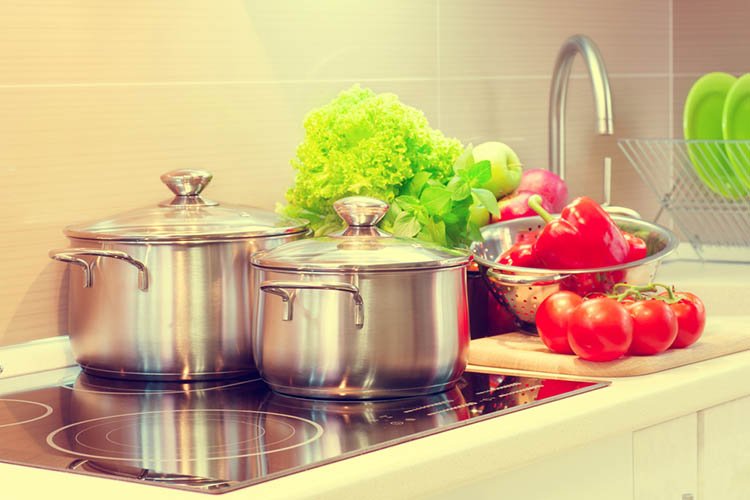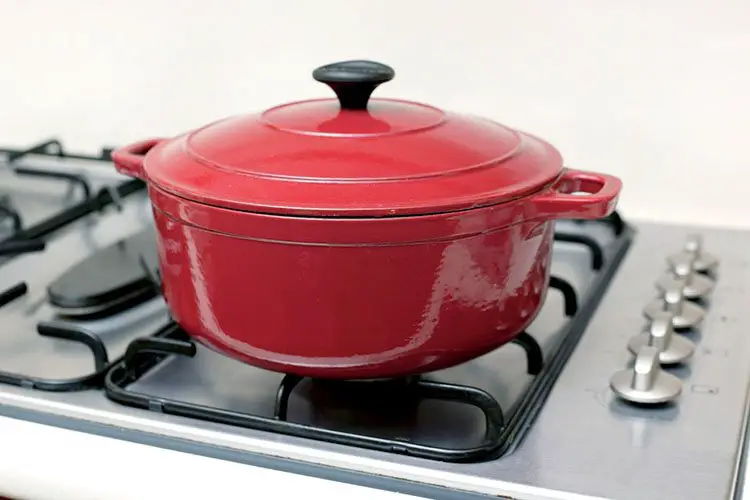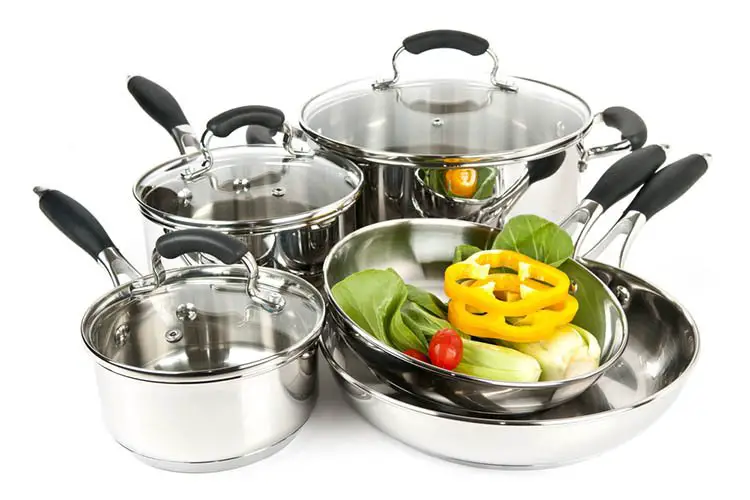Stainless steel cookware is durable, easy to clean, and doesn’t react with acidic foods. Stainless is the choice of most professional chefs and restaurants because it heats evenly. Stainless steel can be used on all cooktops, including induction, whereas ceramic does not.
Ceramic cookware is non-toxic and non-reactive, so doesn’t alter the taste of your food. It’s also lightweight and heats up quickly but can be fragile. One of the biggest drawbacks is that it’s not suitable for induction cooktops.
Ceramic vs. Stainless Steel Cookware
We need to first start with an overview of each of the two types of cookware and then we can compare stainless steel to ceramic.
Ceramic Cookware
Ceramic cookware comes in two forms. The oldest version is made of completely natural sand, clay, and quartz that has been molded and fired. Newer ceramic items are made from metal and are coated with a thin layer of ceramic. Both are then glazed. No toxic chemicals are released when cooking. This cookware comes in a multitude of colors and patterns and there are many shapes and sizes from which to choose, so this means you are likely to find the perfect container for your cooking endeavors.
Ceramic cookware is nearly non-stick as long as you keep your heat low to medium. Higher temperatures may damage the glazing and cause food to stick. This means you won’t need to use a lot of extra oil or butter when you cook. The material is great at conducting heat, however, and not only heats up quickly but also evenly. Cleanup is normally possible with warm water and gentle soap. Most pieces are not made to be put into the dishwasher, but some completely ceramic pieces can be used in a microwave. Manufacturers suggest using only nylon or plastic cooking utensils because the surface can scratch easily, causing the non-stick properties to be compromised. When storing ceramic cookware, it is a good idea to place protective pads between the pieces to avoid chips and scratches.
Pros
- No need for extra oil or butter makes for healthy cooking
- Even heat distribution
- Colors and designs to match any kitchen decor
Cons
- Can scratch or break more easily
- Not for use in dishwasher
- Can’t use metal utensils
Stainless Steel Cookware
Stainless steel cookware is often found in the kitchens of professional chefs. This cookware is created from a mixture of several metals and may include carbon, nickel, manganese, and iron, among others. This combination is extremely strong and resistant to dents and scratches.
One thing to check is the percentage of nickel included in the mixture. This is the second number you will find on the rating of all stainless steel products. For example, a/b shows where a is the percentage of other metals and b is the percentage of nickel. This is only important in regard to those who have nickel allergies. While this isn’t usually an issue, some people are highly sensitive. It is best to choose a stainless steel piece that has zero as the second number.
Stainless steel is versatile in what you can prepare. It is great for high cooking temperatures so that you can sear meat in the pans, yet you can cook delicate foods such as pancakes as well. The silver appearance makes quite an impression in the kitchen. These pans can become discolored with high heat but are easily restored to their shiny glory with a bit of work. Learning to cook in stainless steel can be tricky in regards to sticking food, and you will need to use extra oil and butter. However, there are tricks to help with this problem. A nice perk with stainless steel is that even foods like tomatoes won’t stain the surface. Plus its dishwasher-friendly cookware.
Pros
- Can withstand the full gamut of temperature needs
- It can often be passed down to younger generations because of its durability.
- It doesn’t stain easily from acidic foods.
Cons
- More expensive than other cookware types
- Needs practice for great cooking without food sticking
- Heat distribution can be tricky
A Comparison of Ceramic and Stainless Steel Cookware
Sometimes, comparing the major traits side-by-side helps because you can decide which is most important for your needs.
Before deciding, consider how you use your cookware and what you consider important. Next, compare those things with this list:
- Both ceramic and stainless steel are safe. It is best to check that ceramic is fully ceramic and not just coated and check the nickel content in stainless steel.
- Ceramic cookware is best for non-stick cooking without the use of extra fat calories.
- Stainless steel costs more but it also lasts a lot longer. Only cast iron has a longer lifespan.
- Cleaning is easier with ceramic, but stainless steel can be put in a dishwasher.
- Stainless steel has a shiny, classy look but ceramic cookware comes in various colors and patterns to match your kitchen.
- Ceramic cookware is better at even heat distribution.
Which To Buy?
In the pursuit of a healthier life, one of the biggest factors is in the food we eat. Not only what we eat but how we cook. So it makes sense to give some consideration to the type of cookware we use as well.
Two of the healthiest types of cookware are stainless steel and ceramic, and both are popular options. So if you’ve narrowed it down to these two, which is better – stainless steel or ceramic cookware?
Both ceramic and stainless steel cookware are great choices for safely cooking foods and both can handle a wide variety of cooking needs.
Stainless steel is often the choice of professional chefs because it withstands the widest variety of temperatures when cooking and can handle all manner of tasks. It is also the more expensive of the two.
Ceramic cookware, however, can still last a long time if properly taken care of. It is often the choice of those who don’t cook for large groups or need to use higher temperatures. It can also be purchased to fit in with the overall look and feel of their kitchen.
If in doubt, try one piece of each kind and see which fits your needs and cooking style the best.



